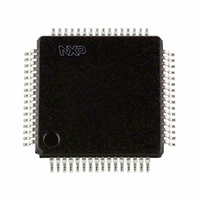TEF6862HL/V1SS422, NXP Semiconductors, TEF6862HL/V1SS422, Datasheet - Page 60

TEF6862HL/V1SS422,
Manufacturer Part Number
TEF6862HL/V1SS422,
Description
IC TUNER CREST SELECTIVE 64LQFP
Manufacturer
NXP Semiconductors
Datasheet
1.TEF6862HLV1S518.pdf
(65 pages)
Specifications of TEF6862HL/V1SS422,
Modulation Or Protocol
AM, FM, WB
Applications
AM/FM Radio Receiver
Current - Receiving
101.9mA
Data Interface
PCB, Surface Mount
Antenna Connector
PCB, Surface Mount
Voltage - Supply
8 V ~ 9 V
Operating Temperature
-40°C ~ 85°C
Package / Case
64-LQFP
Lead Free Status / RoHS Status
Lead free / RoHS Compliant
Features
-
Frequency
-
Sensitivity
-
Memory Size
-
Data Rate - Maximum
-
Lead Free Status / RoHS Status
Lead free / RoHS Compliant, Lead free / RoHS Compliant
Other names
935289087518
Philips Semiconductors
17. Soldering
TEF6862_1
Product data sheet
17.1 Introduction to soldering surface mount packages
17.2 Reflow soldering
17.3 Wave soldering
There is no soldering method that is ideal for all surface mount IC packages. Wave
soldering can still be used for certain surface mount ICs, but it is not suitable for fine pitch
SMDs. In these situations reflow soldering is recommended.
Reflow soldering requires solder paste (a suspension of fine solder particles, flux and
binding agent) to be applied to the printed-circuit board by screen printing, stencilling or
pressure-syringe dispensing before package placement. Driven by legislation and
environmental forces the worldwide use of lead-free solder pastes is increasing.
Several methods exist for reflowing; for example, convection or convection/infrared
heating in a conveyor type oven. Throughput times (preheating, soldering and cooling)
vary between 100 seconds and 200 seconds depending on heating method.
Typical reflow temperatures range from 215 C to 260 C depending on solder paste
material. The peak top-surface temperature of the packages should be kept below:
Table 60.
Table 61.
Moisture sensitivity precautions, as indicated on packing, must be respected at all times.
Conventional single wave soldering is not recommended for surface mount devices
(SMDs) or printed-circuit boards with a high component density, as solder bridging and
non-wetting can present major problems.
To overcome these problems the double-wave soldering method was specifically
developed.
If wave soldering is used the following conditions must be observed for optimal results:
Package thickness
< 2.5 mm
Package thickness
< 1.6 mm
1.6 mm to 2.5 mm
•
•
2.5 mm
2.5 mm
Use a double-wave soldering method comprising a turbulent wave with high upward
pressure followed by a smooth laminar wave.
For packages with leads on two sides and a pitch (e):
July 2004)
2004)
SnPb eutectic process - package peak reflow temperatures (from J-STD-020C
Pb-free process - package peak reflow temperatures (from J-STD-020C July
Rev. 01 — 14 September 2006
Volume mm
260 C + 0 C
260 C + 0 C
250 C + 0 C
Volume mm
240 C + 0/ 5 C
225 C + 0/ 5 C
3
< 350
Car Radio Enhanced Selectivity Tuner (CREST)
3
< 350
Volume mm
2000
260 C + 0 C
250 C + 0 C
245 C + 0 C
3
350 to
© Koninklijke Philips Electronics N.V. 2006. All rights reserved.
Volume mm
225 C + 0/ 5 C
225 C + 0/ 5 C
Volume mm
260 C + 0 C
245 C + 0 C
245 C + 0 C
TEF6862
3
350
3
> 2000
60 of 65













